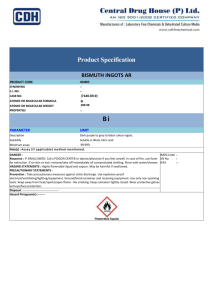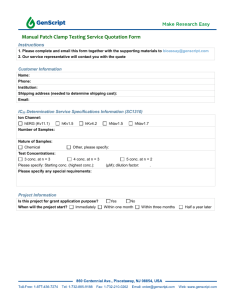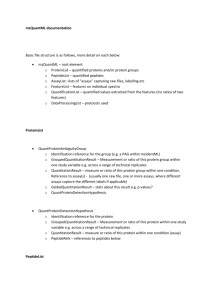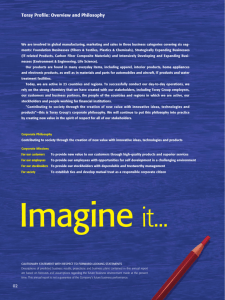Supplementary Materials and Methods (doc 108K)
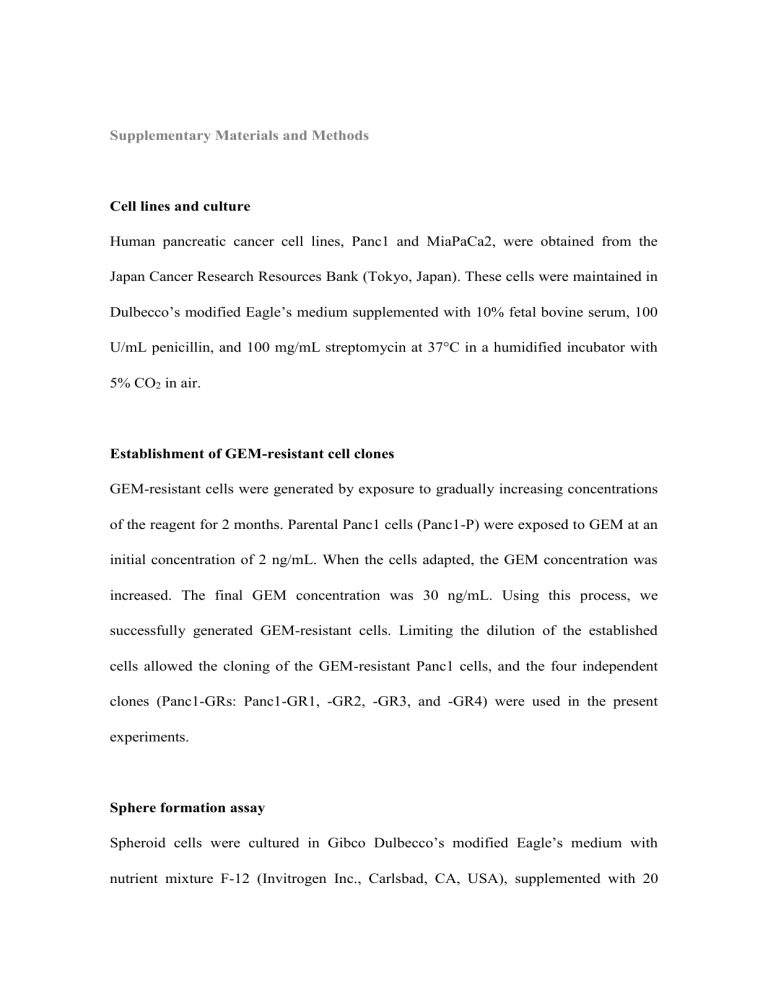
Supplementary Materials and Methods
Cell lines and culture
Human pancreatic cancer cell lines, Panc1 and MiaPaCa2, were obtained from the
Japan Cancer Research Resources Bank (Tokyo, Japan). These cells were maintained in
Dulbecco’s modified Eagle’s medium supplemented with 10% fetal bovine serum, 100
U/mL penicillin, and 100 mg/mL streptomycin at 37°C in a humidified incubator with
5% CO
2
in air.
Establishment of GEM-resistant cell clones
GEM-resistant cells were generated by exposure to gradually increasing concentrations of the reagent for 2 months. Parental Panc1 cells (Panc1-P) were exposed to GEM at an initial concentration of 2 ng/mL. When the cells adapted, the GEM concentration was increased. The final GEM concentration was 30 ng/mL. Using this process, we successfully generated GEM-resistant cells. Limiting the dilution of the established cells allowed the cloning of the GEM-resistant Panc1 cells, and the four independent clones (Panc1-GRs: Panc1-GR1, -GR2, -GR3, and -GR4) were used in the present experiments.
Sphere formation assay
Spheroid cells were cultured in Gibco Dulbecco’s modified Eagle’s medium with nutrient mixture F-12 (Invitrogen Inc., Carlsbad, CA, USA), supplemented with 20
ng/mL of human recombinant epidermal growth factor (Promega Inc., Madison, WI,
USA), 20 ng/mL of basic fibroblast growth factor (PeproTech Inc., Rocky Hill, NJ,
USA), B-27 (Invitrogen), and N2 (Wako Pure Chemical Industries, Ltd., Osaka, Japan), in low-attachment dishes (Corning, Tewksbury, MA, USA) for 7 days. The Panc1-P spheroid cells (Panc1-P (Sp)) were established after completion of this process. The cells were plated at less than 10 cells/μL at 5000 cells/2.5 mL in six-well plates or 1000 cells/100 μL in 96-well plates. To evaluate the sphere formation, the cells were seeded in 96-well flat bottom low-attachment culture dishes (Corning) at 1000 cells/ 100 μL.
Cell counting was performed on day 1, 3, 5, and 7 using Cell Counting Kit-8 (Dojindo
Molecular Technologies, Inc., Rockville, Maryland, USA). After seven days, the size of the spheroid colonies was measured under a microscope and the number of colonies with a diameter over 50 μm was counted. The assay was performed more than three times to confirm reproducibility. The proliferation ratio of spheres was measured by
WST-8 assay. Since the spheroid cells had some chemoresistance, we exposed them to
GEM and 5-FU and performed MTT assays to evaluate cell viability.
Growth inhibitory assay
The growth inhibitory assay was assessed using the
3-(4,5-dimethylthiazol-2-yl)-2,5-diphenyl tetrazolium bromide (MTT; Sigma-Aldrich
Co.) assay as described previously (Eguchi et al , 2000). GEM and 5-fluorouracil (5-FU)
were kindly supplied by Eli Lilly Pharmaceuticals (Indianapolis, IN, USA) and Kyowa
Hakko Kirin Co (Tokyo, Japan), respectively. In brief, cells were incubated for 72 h
under several concentrations of GEM and 5-FU. After reincubation for 4 h with MTT solution, an acid-isopropanol mixture was added to dissolve the resulting formazan crystals. The absorbance of the plate was measured in a microplate reader at a wavelength of 550 nm with a 650 nm reference, and the results were expressed as a percentage of absorbance relative to that of untreated controls.
Flow cytometry
Flow cytometry was performed using the CANTO II cell analyzer (BD Biosciences,
Franklin Lakes, NJ, USA). The cells were harvested and single-cell suspensions were prepared with the aid of StemPro Accutase (Life Technologies, Carlsbad, CA, USA).
The spheroid cells were separated into single-cell suspensions with the aid of collagenase I (Sigma Aldrich Inc., Tokyo, Japan) and adjusted to a concentration of 10 7 cells/mL. To stain surface antigens, the cells were incubated with antibodies against
CD24 and CD44 for 60 min on ice. The fluorophores for each antibody were
CD24-FITC and CD44-PE (BD Biosciences, San Jose, CA, USA). The antibodies against CD24 and CD44 were used at a concentration of 100 μl/mL. Isotype antibodies were used as the negative controls. All FACS analyses were performed three times.
RNA extraction
The total RNA, including the small RNA fraction, was isolated from the cell lines with
Trizol reagent (Invitrogen) as previously described (Yang et al , 2009). The quality of
the RNA was assessed with a NanoDrop ND-1000 spectrophotometer (NanoDrop
Technologies, Wilmington, DE, USA) at 260 and 280 nm (A
260/280
) wavelengths.
Real-time quantitative reverse-transcription-PCR for miRNA expression
The reverse transcription (RT) reaction was performed with the TaqMan MicroRNA RT
Kit (Applied Biosystems, Foster City, CA, USA), and real-time quantitative (q) PCR was performed with the TaqMan MicroRNA Assays (Applied Biosystems) using the
ABI7900HT system (Applied Biosystems). The expressions of the target miRNA were normalized relative to those of the endogenous control, RNU48. Data were analyzed
according to the comparative CT method (Schmittgen et al , 2004).
Real-time qRT-PCR for messenger RNA expression
The complementary DNA was synthesized from 8.0 mg of total RNA using the
SuperScript first-strand synthesis system (Invitrogen), according to the instructions supplied by the manufacturer. The real-time quantitative PCR was performed using designed oligonucleotide primers and the LightCycler 480 Real-Time PCR system
(Roche Diagnostics, Mannheim, Germany). For detection of the amplification products, the LightCycler-DNA master SYBR green I (Roche Diagnostics) was used as described
previously (Yamamoto et al , 2004), and the amount of the target gene expression was
calculated. The expression of the target gene was normalized relative to the expression of GAPDH, which was used as an endogenous control. The designed PCR primers were as follows: GAPDH forward primer 5 ʹ -GTCGGAGTCAACGGATTTGGT-3 ʹ and
GAPDH reverse primer 5 ʹ -GCCATGGGTGGAATCATATTGG-3 ʹ , and CCNG2
forward primer 5 ʹ -TCTCGGGTTGTTGAACGTCTA-3 ʹ , and CCNG2 reverse primer
5 ʹ -GTAGCCTCACACAAACTCAGCC-3 ʹ .
Transfection
The precursor oligonucleotide of hsa-miR-1246 (pre-miR-1246), the antisense oligonucleotide inhibitor of hsa-miR-1246 (anti-miR-1246), the CCNG2 small interfering (si) RNA oligonucleotide (siCCNG2), and their scrambled oligonucleotides were obtained from Ambion Inc. (Austin, TX, USA) and Santa Cruz Biotechnology Inc
(Santa Cruz, CA, USA). The pre/anti-miR-1246 and siCCNG2 were transfected using
Lipofectamine RNAiMAX (Invitrogen) according to the protocol provided by the manufacturer. Each scrambled oligonucleotide was transfected in the same way as a matched negative control.
MiRNA microarray experiments
The purified RNAs obtained from Panc1-P, Panc1-GRs (Panc1-GR1, -GR2, -GR3, and
-GR4), and Panc1-P (Sp) were used as samples; the samples were assessed as being of high quality using the Agilent 2100 Bioanalyzer (Agilent, CA, USA) and labeled with
Hy5 using the miRCURY LNA Array miR labeling kit (Exiqon, Vedbaek, Denmark).
Labeled RNAs were hybridized onto 3D-Gene Mouse miRNA Oligo chips (Toray,
Kamakura, Japan). The annotation and oligonucleotide sequences of the probes were conformed to the miRBase miRNA data base (http://microrna.sanger.ac.uk/sequences/).
After stringent washes, the fluorescent signals were scanned with the 3D-Gene Scanner
(Toray Industries) and analyzed using 3D-Gene Extraction software (Toray Industries)).
The raw data of each spot was normalized by substitution with a mean intensity of the background signal determined by all the blank spots’ signal intensities of 95% confidence intervals. Measurements of spots with the signal intensities greater than two standard deviations (SD) of the background signal intensity were considered to be valid.
A relative expression level of a given miRNA was calculated by comparing the signal intensities of the valid spots throughout the microarray experiments. The normalized data were globally normalized per array, such that the median of the signal intensity was adjusted to 25.
Gene microarray analysis and gene set enrichment analysis (GSEA)
For the Oligo DNA microarray analysis, RNA samples were collected from Panc1-P,
Panc1-GRs (Panc1-GR1, -GR2, -GR3, and -GR4), and Panc1-P (Sp). The 3D-Gene
Mouse Oligo chip 24k (Toray Industries) was used (23,522 distinct genes). For efficient hybridization, this microarray had three-dimensions that were constructed with a well as the space between the probes and cylinder-stems with 70-mer oligonucleotide probes at the top. The total RNA was labeled with Cy5 using the Amino Allyl MessageAMP II aRNA Amplification Kit (Applied Biosystems). The Cy5-labeled aRNA pools and hybridization buffer, and hybridized for 16 h. The hybridization was performed using the supplier's protocols (www.3d-gene.com). The hybridization signals were scanned with the 3D-Gene Scanner (Toray Industries) and processed by 3D-Gene Extraction software (Toray Industries). The raw data of each spot was normalized by subtraction
with a mean intensity of the background signal determined by using all blank spots ʹ signal intensities of the 95% confidence intervals. The raw data that were intensities greater than two standard deviations (SD) of the background signal intensity were considered to be valid. Detected signals for each gene were normalized by the global normalization method (the median of the detected signal intensity was adjusted to 25).
To identify gene-signature-based differences between two cell populations (spheroid
Panc1-P vs. adherent Panc1-P), we performed GSEA, provided by the Broad Institute of the Massachusetts Institute of Technology (Cambridge, MA, USA) as reported
previously (Subramanian et al , 2005). All probe sets with coding genes were ranked
using the log2 value of the ratio of the two groups’ expression values. We focused on one of the six major MSigDB collections,
(gseaftp.broadinstitute.org://pub/gsea/gene_sets/c2.all.v4.0.symbols.gmt). c2
The enrichment score (ES) was a measure of the degree to which a gene set was over-represented in the extreme of the entire ranked gene list. In order to statistically assess the ES, ES was normalized into normalized ES (NES) using the permutation test
(1000 times); the permutation type was configured to the gene-set to avoid the potential problem of a small sample size. False Discovery Rate (FDR) q-value was the estimated probability that a gene set with a given NES represented a false positive finding.
Apoptosis assay
The binding of Annexin V was used as a sensitive method for measuring apoptosis, as
described previously (Nakamura et al , 2007). The cells were stained with Annexin
V-FITC and propidium iodide (PI) (BioVision Research Products, Mountain View, CA,
USA), and analyzed using CANTO II (BD Biosciences). The Annexin V-positive and
PI-negative cells were considered as early apoptotic cells and the Annexin V-positive and PI-positive cells were considered as late apoptotic cells. Those population cells
were used to assess apoptosis in the study (Lugli et al , 2005). Panc1 cells were exposed
to GEM 50 ng/mL for 72 hours and MiaPaCa2 cells were exposed to GEM 50 ng/mL for 48 hours after transfection. After that, this assay was used on those cells.
Western blotting
For Western blot analysis, cells were lysed in N08 buffer [25mM Tris-Cl (pH 7.6), 150 mM NaCl, 1% Nonidet P-40, 1% Na-deoxycholate, 1% sodium dodecyl sulfate] and the samples were separated by SDS-PAGE and transferred onto a polyvinylidene difluoride
(PVDF) Immobilon-P membrane (Millipore, Billerica, MA, USA). The membrane was blocked with 5% skimmed milk/TBS-Tw and probed with the relevant antibodies, polyclonal anti-human CyclinG2 (CCNG2) antibody (MBL, Nagoya, Japan) and monoclonal anti-α-tubulin antibody (B-5-1-2, Sigma, Tokyo, Japan) respectively.
Immunoreactive protein bands were visualized using Western Lightning Plus-ECL
(PerkinElmer Inc., Santa Clara, CA, USA). This process was performed according to a
previous report (Naito et al , 2013). The relative ratio of protein quantification was
measured using Image J software (http://rsb.info.nih.gov/ij/).
Immunohistochemical staining
The immunohistochemical staining for CCNG2 in 24 pancreatic cancer samples was
performed using the method described previously (Kondo et al , 1999). Briefly, FFPE 4
μm thick sections were deparaffinized in xylene, then treated with an antigen-retrieval procedure, and incubated in methanol containing 0.3% hydrogen peroxide to block endogenous peroxidase. After incubation with normal protein block serum, the sections were incubated overnight at 4 ºC with an anti-CCNG2 antibody as the primary antibody
(MBL Inc.). Thereafter, the sections were detected with avidin-biotin complex reagents
(Vector Laboratory Inc., Burlingame, CA, USA) and diaminobenzidine. All sections were counterstained with hematoxylin. Positivity for CCNG2 staining was defined as detectable nuclear staining of >10% of the cancer cells.
References
Eguchi H, Nagano H, Yamamoto H, Miyamoto A, Kondo M, Dono K, Nakamori S,
Umeshita K, Sakon M, Monden M (2000) Augmentation of antitumor activity of
5-fluorouracil by interferon alpha is associated with up-regulation of p27Kip1 in human hepatocellular carcinoma cells. Clin Cancer Res 6: 2881 - 2890
Kondo M, Yamamoto H, Nagano H, Okami J, Ito Y, Shimizu J, Eguchi H, Miyamoto A,
Dono K, Umeshita K, Matsuura N, Wakasa K, Nakamori S, Sakon M, Monden M
(1999) Increased expression of COX-2 in nontumor liver tissue is associated with shorter disease-free survival in patients with hepatocellular carcinoma. Clin Cancer Res
5: 4005 - 4012
Lugli E, Troiano L, Ferraresi R, Roat E, Prada N, Nasi M, Pinti M, Cooper EL,
Cossarizza A (2005) Characterization of cells with different mitochondrial membrane potential during apoptosis. Cytometry A 68: 28 - 35
Naito Y, Yabuta N, Sato J, Ohno S, Sakata M, Kasama T, Ikawa M, Nojima H (2013)
Recruitment of cyclin G2 to promyelocytic leukemia nuclear bodies promotes dephosphorylation of gammaH2AX following treatment with ionizing radiation. Cell
Cycle 12(11): 1773 - 1784
Nakamura M, Nagano H, Sakon M, Yamamoto T, Ota H, Wada H, Damdinsuren B,
Noda T, Marubashi S, Miyamoto A, Takeda Y, Umeshita K, Nakamori S, Dono K,
Monden M (2007) Role of the Fas/FasL pathway in combination therapy with interferon-alpha and fluorouracil against hepatocellular carcinoma in vitro. J Hepatol
46: 77 - 88
Schmittgen TD, Jiang J, Liu Q, Yang L (2004) A high-throughput method to monitor the expression of microRNA precursors. Nucleic acids research 32: e43
Subramanian A, Tamayo P, Mootha VK, Mukherjee S, Ebert BL, Gillette MA,
Paulovich A, Pomeroy SL, Golub TR, Lander ES, Mesirov JP (2005) Gene set
enrichment analysis: a knowledge-based approach for interpreting genome-wide expression profiles. Proc Natl Acad Sci U S A 102: 15545 - 15550
Yamamoto T, Nagano H, Sakon M, Wada H, Eguchi H, Kondo M, Damdinsuren B, Ota
H, Nakamura M, Marubashi S, Miyamoto A, Dono K, Umeshita K, Nakamori S, Yagita
H, Monden M (2004) Partial contribution of tumor necrosis factor-related apoptosis-inducing ligand (TRAIL)/TRAIL receptor pathway to antitumor effects of interferon-alpha/5-fluorouracil against Hepatocellular Carcinoma. Clin Cancer Res 10:
7884 - 7895
Yang MH, Chen CL, Chau GY, Chiou SH, Su CW, Chou TY, Peng WL, Wu JC (2009)
Comprehensive analysis of the independent effect of twist and snail in promoting metastasis of hepatocellular carcinoma. Hepatology 50: 1464 - 1474


